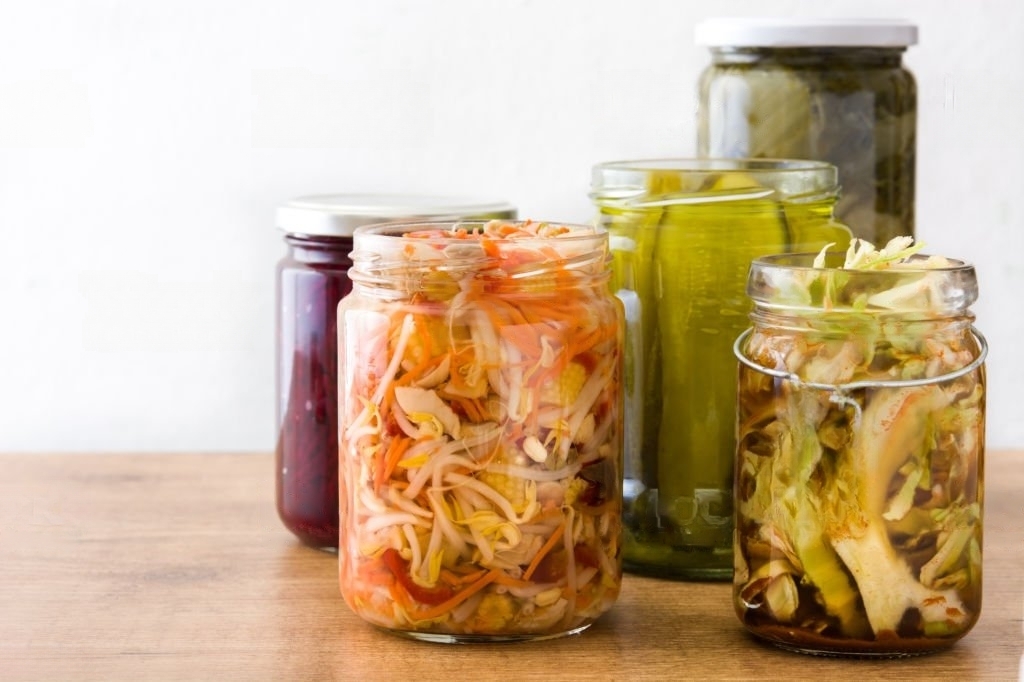Sauerkraut.
Sauerkraut is a fermented cabbage dish that has been a staple in Central and Eastern European cuisine for centuries. It is made by finely shredding cabbage and fermenting it with lactic acid bacteria, primarily the species Lactobacillus.
Sauerkraut and gut health.
Sauerkraut is known for its potential to support a healthy gut. It is considered a probiotic food because it contains live bacteria that can contribute to the balance of beneficial microorganisms in the gut. These beneficial bacteria, when consumed, can help improve digestion and overall gut health.
It’s not prebiotic fiber.
While sauerkraut is not considered a prebiotic fiber itself, it does contain dietary fiber, which can provide various benefits to the digestive system. Fiber helps promote regular bowel movements, supports the growth of beneficial gut bacteria, and can contribute to a feeling of fullness.
Nutrient contained.
In terms of nutrient content, sauerkraut is a good source of vitamins C and K, as well as various minerals such as calcium, magnesium, and potassium. However, the nutrient content may vary depending on the specific preparation method and fermentation process used.
Glucosinolates
Sauerkraut does contain glucosinolates, which are sulfur-containing compounds found in cabbage and other cruciferous vegetables. These compounds have been associated with potential health benefits, including antioxidant and anti-cancer properties. When sauerkraut is consumed, the glucosinolates can be converted into isothiocyanates, which are bioactive compounds that may have anti-inflammatory and anti-cancer effects in the human body.
Isothiocyanate.
The conversion of glucosinolates into isothiocyanates occurs during the fermentation process. The lactic acid bacteria present in sauerkraut help break down the glucosinolates into various compounds, including isothiocyanates.
Prepration of sauerkraut.
Sauerkraut can be prepared at home or purchased commercially.
To make sauerkraut,
- you typically start by shredding cabbage finely .
2. Add salt. The salt helps draw out the moisture from the cabbage, creating an environment for fermentation.
3. The cabbage is then packed tightly into a jar or fermentation vessel .
4. left to ferment for several weeks at room temperature.
During fermentation, lactic acid bacteria naturally present on the cabbage or added as a starter culture convert the sugars in the cabbage into lactic acid, which gives sauerkraut its tangy flavor.
The benifit to consume sauerkraut.
The main benefit of consuming sauerkraut is its potential to support gut health due to its probiotic properties. The live bacteria present in sauerkraut can help improve digestion, enhance nutrient absorption, and strengthen the immune system. Additionally, sauerkraut is low in calories, a source of dietary fiber, and contains important vitamins and minerals, making it a nutritious addition to meals..
Sauerkraut FAQ
Q: How can sauerkraut be incorporated into recipes?
A: Sauerkraut can be enjoyed on its own as a side dish or condiment, but it is also a versatile ingredient in various recipes. It adds a tangy flavor and texture to dishes such as sausages, sandwiches, and salads. Sauerkraut can be used as a topping for hot dogs or burgers, added to soups and stews, or even incorporated into baked goods like savory breads and pierogies. The possibilities are endless!
Q: Is sauerkraut suitable for everyone?
A: While sauerkraut is generally considered safe and healthy for most people, there are a few considerations to keep in mind. The fermentation process may produce histamines, which can trigger allergic reactions or migraines in some individuals. People with certain health conditions, such as histamine intolerance or irritable bowel syndrome (IBS), may need to limit their intake of sauerkraut or fermented foods. It’s always a good idea to consult with a healthcare professional if you have specific dietary concerns or health issues.
Q: Does sauerkraut have any culinary variations?
A: Yes, sauerkraut can be prepared in different ways to create variations in taste and texture. Some recipes may include additional ingredients such as caraway seeds, juniper berries, apples, onions, or spices to enhance the flavor. The length of fermentation can also affect the taste of sauerkraut, with shorter fermentation periods resulting in a milder flavor and longer fermentation yielding a stronger, more tangy taste. Regional variations may exist, reflecting the culinary traditions of different countries and cultures.
Q: How should sauerkraut be stored?
A: Sauerkraut can be stored in airtight containers or glass jars in the refrigerator to slow down the fermentation process. Properly stored sauerkraut can last for several months or even up to a year. It’s important to ensure that the sauerkraut is fully submerged in its brine to prevent it from spoiling. If you have homemade sauerkraut that has been canned or preserved using proper canning methods, it can be stored at room temperature until opened, but once opened , must store in refrigerator.
{Nutrition Life Circle}

My Self Hari singh choudhary
S.N.H.S. Dip.(Holistic nutrition), London, S.N.H.S. Dip. (Advanced Nutrition), London, S.N.H.S. Dip. (Holistic Pain Management), London, S.N.H.S. Dip. (Nutrition for Age 50+), London, S.N.H.S. Dip. (Plant-Based Nutrition), London, S.N.H.S. Dip. (Vegetarian & Vegan Nutrition,) London, Certified Diabetes Educator’s (INDO-VIETNAM MEDICAL BOARD, Associate member of The International College of Holistic Medicine, England.
NATURAL DISEASE ERADICATION
[ NUTRITION THERAPY ]
For Business inquiry:-
Email: nutritionlifecircle@gmail.com
WhatsApp Number: +91 9425090558
